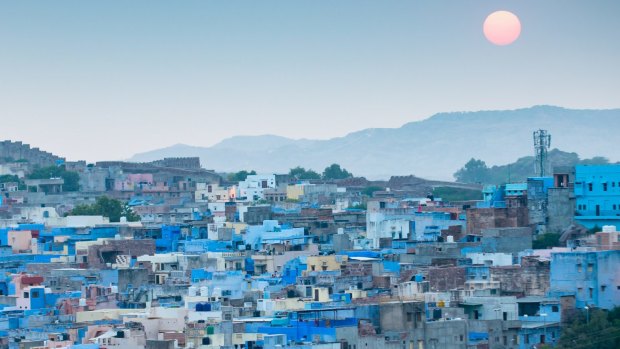
Jodhpur, the Blue City, Rajasthan.Credit: Getty Images
We step off the boat and onto a floating platform where an impeccably dressed man with a fabulous moustache is waiting for us. Holding an umbrella adorned in colourful jewels to shade us from the scorching Rajasthan sun, he greets us with a wide smile, his moustache coiling upwards as he does so. It's only five, maybe six, metres from the boat ramp to the Taj Lake Palace hotel entry, but clearly protecting us from the sun is imperative.
As we approach the entrance we are engulfed by a shower of fragrant rose petals – little sweet smelling bursts of pinks and reds finding their place on our sweat-drenched bodies. When I turn to look back a few seconds later somebody is already sweeping the rose petals away. Exploring Rajasthan in luxury has that effect on you – we are continually swept away in moments of sheer magnificence.
It has been 10 years since I've been to India. Last time my husband and I explored the intoxicating and addictively odd country in true backpacker style. We roamed the streets eternally hunched over thanks to our weighty backpacks; we scoured tattered notices advertising cheap hostels in cafes we'd read about in Lonely Planet; we joined the locals on buses so jam-packed we're probably in the background of one of those "only in India" photos that float around the net.
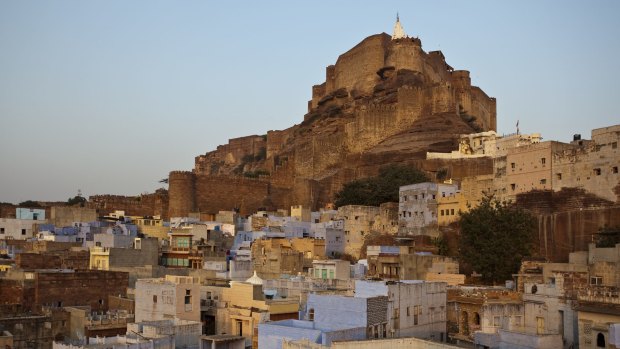
Mehrangarh Fort is managed as a museum by the royal trust.Credit: Getty Images
This time we're on a customised private tour with Pure India Collection, a boutique travel company, and it's completely opposite in terms of experience. We have no backpacks and we seldom touch our suitcases. They vanish once we're packed and reappear in our next room. On one occasion I'm sure they come back cleaner than when they'd left …
Our focus is to simply soak up ravishing Rajasthan. Having visited Delhi and Agra previously we're voyaging further south beyond the Golden Triangle route (Delhi, Agra and Jaipur). Jaipur is the only Rajasthan city in the circuit and the start point of our adventure.
Rajasthan translates to "Land of the Kings" and back in the heyday of regal supremacy there were hundreds of royals – or maharajas and maharanis, as they're known in India. When India gained independence in 1947 India's royalty lost their official powers, but many of them retained their wealth.
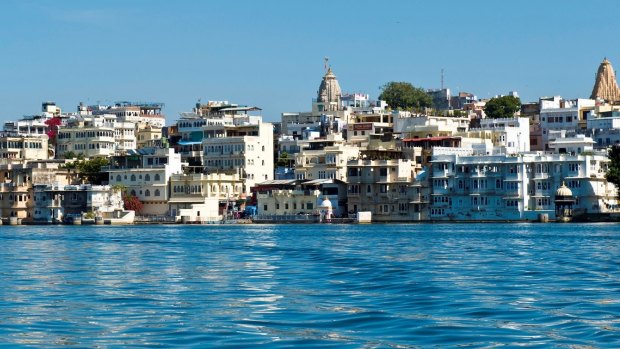
Pichola Lake, Udaipur. Credit: Getty Images
Working towards democracy, in 1971 Indira Gandhi, India's only female prime minister to date, stipulated that royal families pay high taxes on their properties. Some became influential businessmen and women, others transformed their residencies into sumptuous hotels and enormous museums; many did both. It's thanks to this strategic move that guests – like us – are able to sojourn at former palaces and get a taster of royal life. Our first stop after Jaipur, the Umaid Bhawan Palace in Jodhpur, is one of the most spectacular examples.
Our driver Ram is quite the master at navigating and our trip from Jaipur to Jodhpur is as humdrum as a drive on an Indian highway can be (meaning plenty of beeps and commotion). We coast into Jodhpur early afternoon as dappled sunlight bathes the brilliant blue city in a deep orange hue.
There are many cities in India with colourful nicknames (for example Jaipur is known as the pink city while Nagpur is the orange city), usually coming from unique architectural features of the city. Predictably, the bulk of the buildings in Jodhpur are painted blue – a stark contrast to the parched land around and made all the more dazzling for it.
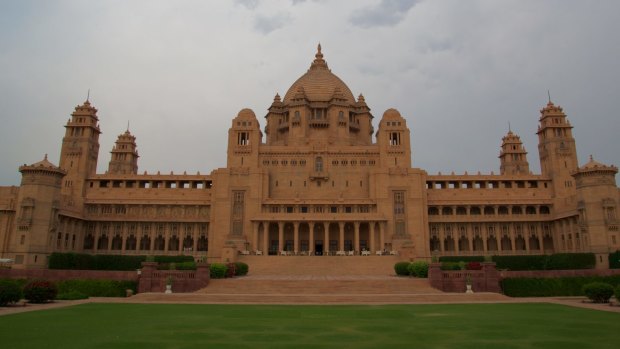
Umaid Bhawan Palace, Jodhpur.Credit: Evan Dickson
There are several theories as to why the buildings were painted blue. Some say locals painted their homes blue to keep them cool; others say the blue paint kept insects away; it's also believed that Brahmins (members of the Hinduism priesthood) painted their residences blue to stand out. Whatever the reason, residents upheld the tradition, with the highest density of blue edifices found in the Old Town. Every time we transfer cities Ram ensures that our first port of call is our hotel, and since we have just one night at Umaid Bhawan Palace, we make the most of our afternoon and join an early evening tour of the grounds.
Small in stature and sporting long lustrous hair, our chaperone is wearing the shiniest shoes I've ever seen; so glossy I can see the chandeliers reflected in them. She takes us on an expedition, weaving through various chambers and halls chatting royal history.
Built between 1928 and 1943 for Maharaja Umaid Singh, the grandiose yellow sandstone palace is still home to the royals – who reside in a portion that we regrettably don't get to visit. We do, however, amble through many magnificent rooms that were once only accessible to the royal family and their guests. I admire the vast antiques collection, the gilded furnishings and the exquisite artworks and try to imagine what royal life was like.
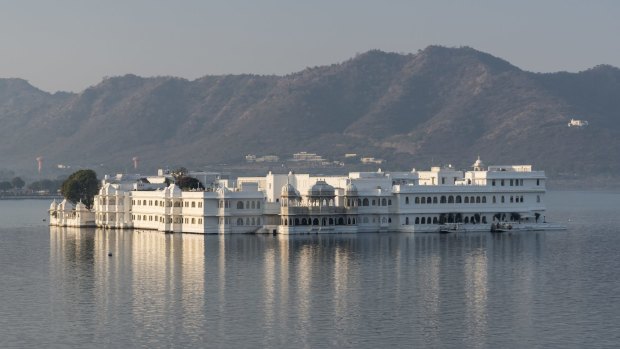
Lake Palace Hotel on Lake Pichola, Udaipur, Rajasthan.Credit: Getty Images
Our guide explains that the palace was built as an additional residence for the royal family, whose numbers at the time had outstripped the colossal Mehrangarh Fort. Upon completion it was used as the chief residence.
Outside the sheer size of the perfectly manicured lawns dumbfounds. The palace itself is gigantic, but the palace grounds look like they stretch on endlessly. I challenge a fellow guest to a brief game of squash on the marbled courts, pretty sure I left my husband behind in the Trophy Bar, a moody space decked out in hunting-themed decor, with some of the other guys.
Come sunset everyone re-emerges outside as the palace edifice transmutes from sandy yellow to flaming orange and finally an escalating series of pinks. We all stare and snap photos and the clever ones run to the restaurant to snag a courtyard table for dusk drinks.
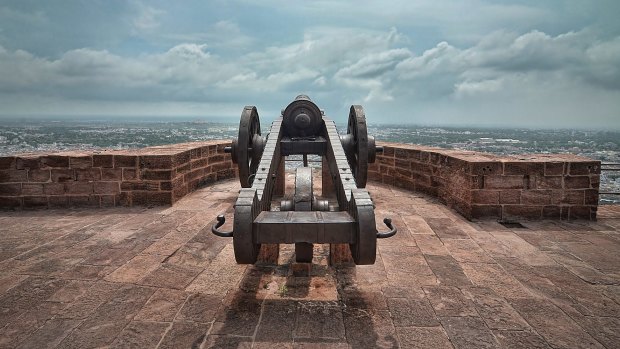
Mehrangarh Fort, Jodhpur, India.Credit: Getty Images
Although not maintained to the same standards, the hilltop Mehrangarh Fort is managed as a museum by the royal trust. It's just as impressive and we while away a few hours here the following day.
Like many of the forts in India, it was built primarily for military use. Inside we explore a number of beautiful palaces and lavish apartments, my favourite being the Rang Mahal (Palace of Colours). Decorated with intricate mirrors, multi-coloured glasswork and gold leaf motifs, it shouts India to me – colourful, chaotic, sometimes mismatched, yet irresistibly beautiful.
We conclude the tour on the roof. Although there are a few canyons scattered around reminding visitors of the fort's battle-scorched history, it's the sprawling vistas of the Thar Desert contrasted so peculiarly with the indigo blue homes that capture my attention.
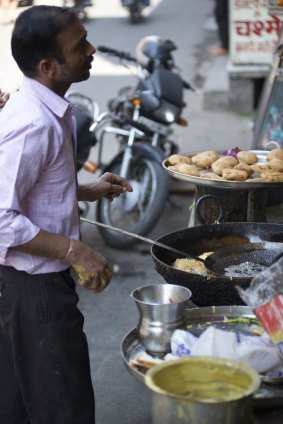
Street vendor.Credit: Evan Dickson
Extraordinary panoramas become the norm on our trip. We always stay somewhere with views and our arrival at the Taj Lake Palace in Udaipur seals the I'm-in-paradise deal.
The hospitable concierge with the umbrella impresses us first off, but then we're ferried away, welcome drinks in hand, to our suite … that just so happens to have a giant swing in the middle of it. The swing is nothing like the flimsy kind you see in parks … no, this is a hefty brass structure with a soft velvet pillow on top. I jump right on and come to the conclusion that the Princess (our suite was once her room) and I could be friends in another lifetime.
Next I fling open one of the many stained glass windows and sink into a bay window nook to gaze at the City Palace complex, our first stop tomorrow.
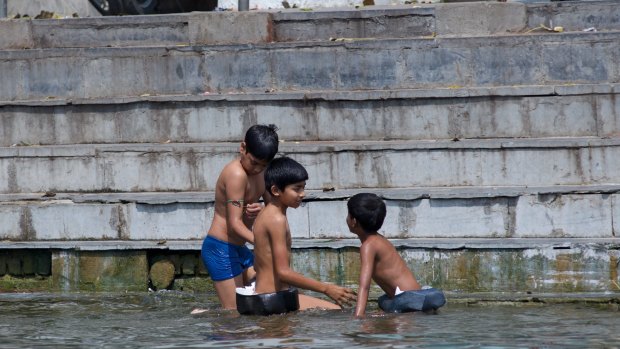
Children play in the waters of Lake Pichola.Credit: Evan Dickson
Tonight we have other plans. How often can you go on a boat cruise in the desert? Our private hotel boat whisks us to another jetty where we join a small group for our sunset cruise. Our skipper takes it slow, smoothly steering the boat across Lake Pichola.
We sit back and watch the real-time spectacle that is Udaipur life. We drift past extravagant havelis – homes to Udaipur's elite. We pause outside the majestic City Palace and ogle the ornate structure. We cruise around the islands, slowing down when we near other palaces, such as our hotel and Arsi Vilas, an 18th-century home that now acts as function space and bird sanctuary.
When the sun begins to sink into the horizon the lake transforms into a shimmering splendour and the beauty around us intensifies. The grand mountains in the distance appear to soar higher, the palaces peppered around the islands twinkle in the late-day hue, and a flock of colourful birds suddenly appear and flutter around us. When it's time to get off the boat we linger. Although our palace awaits us, we have just one night left and will do whatever we can to prolong our royal Rajasthan experience.
FIVE MORE STUNNING RAJASTHAN CITIES
JAIPUR
Rajasthan's capital city is also the state's largest. Nicknamed the pink city because of the abundance of pink buildings throughout, there's plenty to see, including forts, temples, museums and marketplaces.
ALWAR
A popular tourist hot spot, Alwar is one of the oldest Rajasthan cities and the closest metropolis to the Sariska Tiger Reserve and National Park, one of India's most-visited parks.
JAISALMER
Nicknamed the golden city, Jaisalmer is located in the heart of the Thar Desert near the border of Pakistan. There's plenty to see, including an impressive fort and plenty of ancient havelis. Camel safaris are easy to organise from here.
PUSHKAR
Popular with pilgrims, Pushkar is one of India's oldest cities and famous for its many temples and ghats (riverside steps used by residents for bathing). The five-day Pushkar Camel Fair, held every November, is a calendar highlight.
CHITTORGARH
Often simply called Chittor, you'll find India's largest fort, Chittorgarh Fort, here. Spread over 2.8km it's home to many palaces, temples and gardens.
TRIP NOTES
MORE INFORMATION
GETTING THERE
Air India flies from Sydney and Melbourne direct to Delhi and from there, connects to Jodhpur and Udaipur. Phone 1800 247 463; see airindia.in
SEE + DO
Pure India Collection is designed to be the ultimate in enriching and unique luxury travel experiences. Itineraries are fully customised and include accommodation, activities, guides, drivers and transfers. Phone 1300 365 060; see pureindiacollection.com.au
STAYING THERE
Taj Hotels' Umaid Bhawan Palace in Jodhpur and the Taj Lake Palace in Udaipur offer the ultimate royal Rajasthan experience; see tajhotels.com
Tatyana Leonov was a guest of Pure India Collection and Air India.
Sign up for the Traveller Deals newsletter
Get exclusive travel deals delivered straight to your inbox. Sign up now.